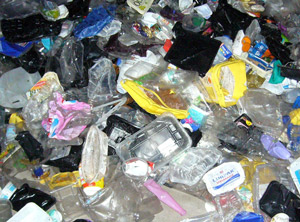PLASTICS AND ENVIRONMENT
Landfilling plastic waste could be better than burning for energy / Carbon tax should be transformed to reflect true “environmental” cost / Axion Consulting chief executive Keith Freegard
Sending waste plastics to landfill rather than incinerators might be better for the environment, Keith Freegard, director of Axion Consulting (Bramhall, Cheshire / UK; www.axionconsulting.com), suggests. While his statement might be seen as controversial and certainly not environmentally friendly at first, Freegard believes that revisiting the decision-making metrics behind the accepted practice of burning waste plastics could reveal that using landfill instead might make more sense.
 Is landfill a better option than incineration? (Photo: Axion Consulting) |
What if the true environmental cost of CO2 emissions was also factored into deciding the best option, he asks. He argues that when the full carbon cost of the waste disposal method is expressed in “pound notes” – reflecting the impact that large-scale CO2 has upon the planet – then this metric could change decisions about what is considered to be “good” waste material to burn as fuel and what is “bad”.
Freegard hypothesises that if the waste plastic could be separated from the organic or renewable carbon waste and stored either in the ground or in a covered storage system, it would represent a long-term “carbon sink”. It would also remove the fossil-based material from the feed for energy-from-waste (EfW) plants.
A typical EfW plant has efficiencies of up to 30% for converting into electricity. Axion’s data shows that, to produce 1 MWh of electricity, an EfW facility needs 345kg of waste plastic and releases 880kg of CO2. This compares with a combined cycle gas turbine, where efficiency is typically about 50%, which requires 132kg of natural gas and releases only 360kg of CO2.
“Using the CO2 metric alone suggests that it makes more sense to bury a large amount of plastic in a long-term 'carbon sink' in the ground and efficiently combust natural gas to satisfy our immediate power needs,” Freegard says.
However, until such time when world leaders transform taxes on fossil fuel use in a way that truly reflects the high cost of “free carbon release”, Freegard says this numeric analysis “remains an esoteric academic study.”
He believes that changing corporate and national energy habits to leave fossil fuels in the ground will only happen with a carbon tax, particularly in relation to generating electricity and directly linked to the CO2 tonnes released into the atmosphere per unit of fossil carbon consumed. If that happens, it might pay to return to the volumes of stored plastic and look at the economics of turning it into new polymer. “With a huge carbon tax slapped on burning it, then the economics would probably work. So these plastics may not have to stay in the ground for too long,” comments Freegard.
The issue remains a complex and challenging one, and one that stretches long into the years ahead. Freegard does not expect any real change unless there is a tax that puts some “seriously big pound notes” on the cost of throwing carbon into the atmosphere. Tongue in cheek, he concludes: “The earth doesn’t have a bank account – it’s us humans who operate under that monetary metric.”
Freegard hypothesises that if the waste plastic could be separated from the organic or renewable carbon waste and stored either in the ground or in a covered storage system, it would represent a long-term “carbon sink”. It would also remove the fossil-based material from the feed for energy-from-waste (EfW) plants.
A typical EfW plant has efficiencies of up to 30% for converting into electricity. Axion’s data shows that, to produce 1 MWh of electricity, an EfW facility needs 345kg of waste plastic and releases 880kg of CO2. This compares with a combined cycle gas turbine, where efficiency is typically about 50%, which requires 132kg of natural gas and releases only 360kg of CO2.
“Using the CO2 metric alone suggests that it makes more sense to bury a large amount of plastic in a long-term 'carbon sink' in the ground and efficiently combust natural gas to satisfy our immediate power needs,” Freegard says.
However, until such time when world leaders transform taxes on fossil fuel use in a way that truly reflects the high cost of “free carbon release”, Freegard says this numeric analysis “remains an esoteric academic study.”
He believes that changing corporate and national energy habits to leave fossil fuels in the ground will only happen with a carbon tax, particularly in relation to generating electricity and directly linked to the CO2 tonnes released into the atmosphere per unit of fossil carbon consumed. If that happens, it might pay to return to the volumes of stored plastic and look at the economics of turning it into new polymer. “With a huge carbon tax slapped on burning it, then the economics would probably work. So these plastics may not have to stay in the ground for too long,” comments Freegard.
The issue remains a complex and challenging one, and one that stretches long into the years ahead. Freegard does not expect any real change unless there is a tax that puts some “seriously big pound notes” on the cost of throwing carbon into the atmosphere. Tongue in cheek, he concludes: “The earth doesn’t have a bank account – it’s us humans who operate under that monetary metric.”
23.12.2016 Plasteurope.com [235814-0]
Published on 23.12.2016
